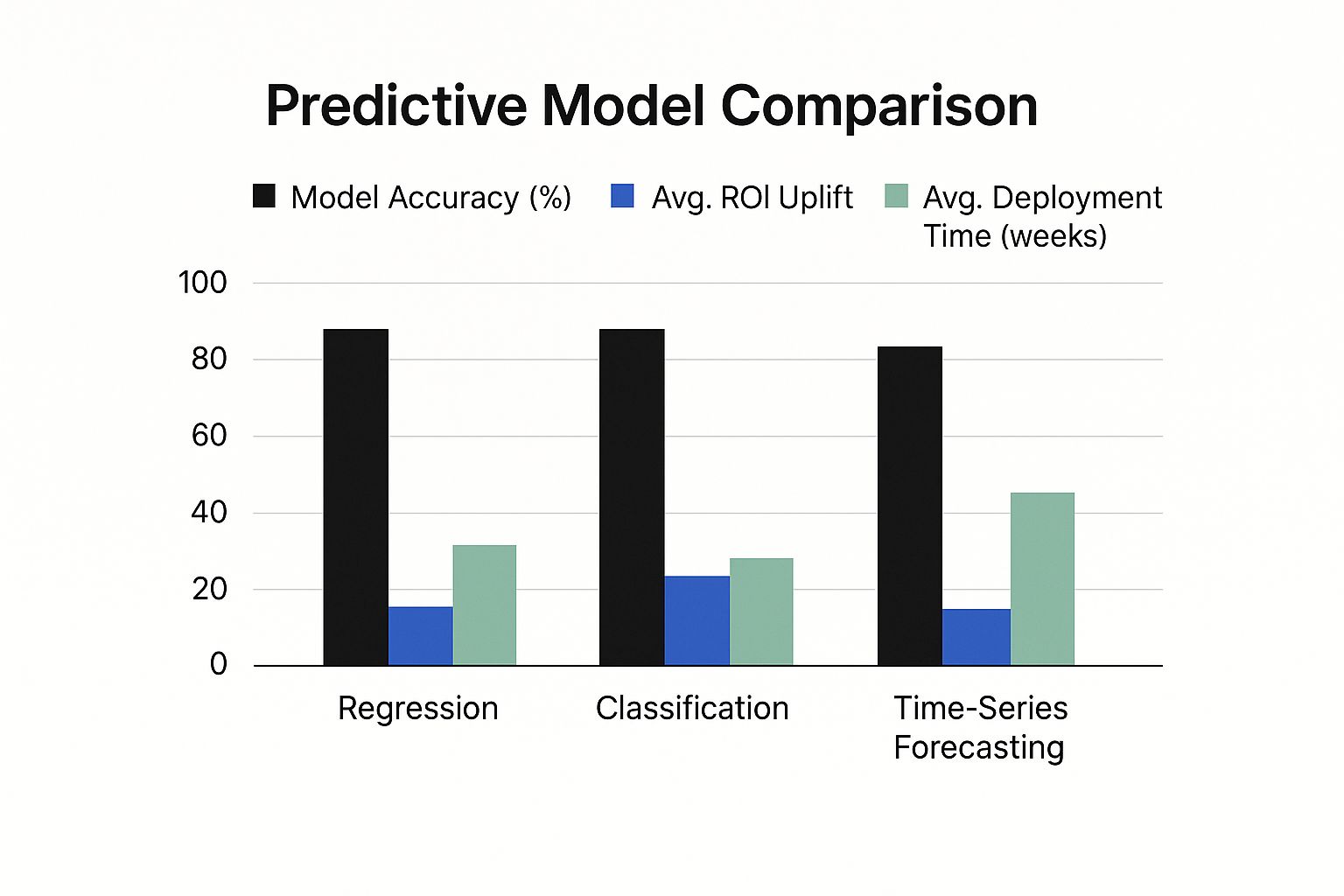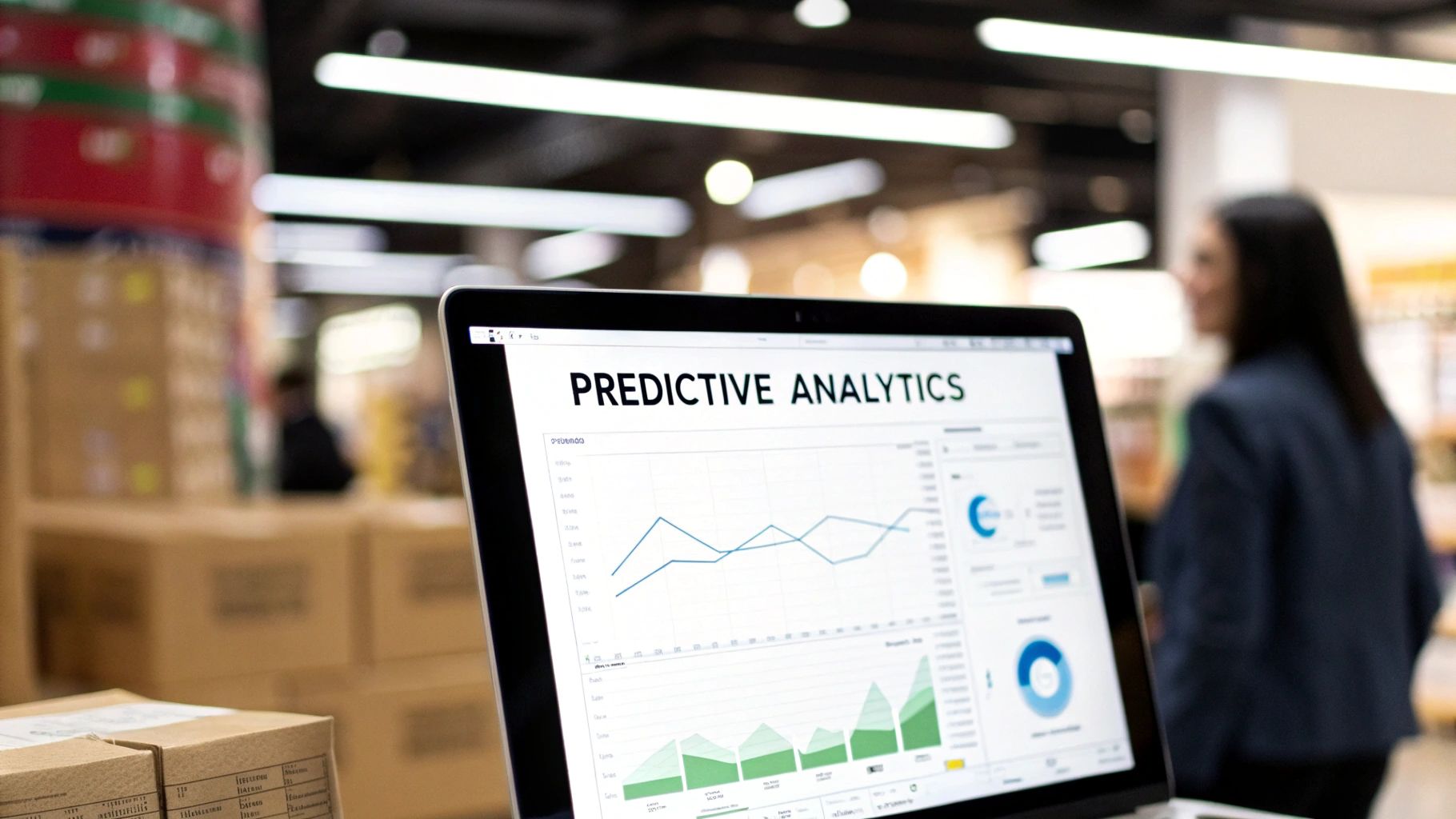The State of Predictive Analytics in UK Ecommerce
Predictive analytics is becoming increasingly important for success in the competitive UK ecommerce market. This data-driven approach helps businesses anticipate customer behavior, optimize operations, and improve their bottom line. It’s no longer a luxury, but a necessity for staying ahead of the competition.
The Growing Importance of Data in UK Online Retail
The UK has the largest ecommerce market in Europe, and its impact is significant. Predictive analytics plays a vital role in this thriving sector, allowing businesses to gain valuable insights from the vast amounts of data generated daily. This leads to more informed decisions, better customer experiences, and ultimately, higher profitability. For example, predictive models can anticipate changes in demand, enabling businesses to optimize their inventory and avoid stockouts or excess inventory.
This emphasis on data is driven by the sheer scale of the UK ecommerce market. It's currently the largest in Europe and among the biggest globally. By 2025, the UK ecommerce user base is expected to reach 62.1 million. Find more detailed statistics here The average online spending per UK shopper is projected at $4,679. This high transaction value presents a great opportunity for predictive analytics to optimize sales by forecasting demand and understanding customer preferences.
To better understand the current landscape and the potential impact of predictive analytics, let's look at some key statistics. The following table, "UK Ecommerce Market at a Glance," highlights the size and growth of the UK market and the potential benefits of using predictive analytics.
| Metric | Value | Predictive Analytics Opportunity |
|---|---|---|
| Ecommerce Market Size (2025) | 62.1 million users | Personalized targeting and customized offers |
| Average Online Spending (Projected) | $4,679 per shopper | Demand forecasting and optimized pricing strategies |
| Market Growth | Continuously expanding | Enhanced customer retention through predictive modeling |
These figures demonstrate the significant potential for data-driven personalization and forecasting models within the UK ecommerce market. By leveraging these insights, businesses can improve customer experiences and drive revenue growth.
Key Applications of Predictive Analytics
Predictive analytics offers a wide range of applications in UK ecommerce:
-
Demand Forecasting: Accurately predict future demand to optimize inventory and minimize storage costs while preventing stockouts.
-
Personalized Recommendations: Tailor product suggestions to individual customer preferences, which can increase conversion rates and average order values.
-
Churn Prevention: Identify customers at risk of churning and implement targeted retention strategies to build customer loyalty.
-
Fraud Detection: Detect and prevent fraudulent activities to protect revenue and safeguard both businesses and customers.
-
Price Optimization: Dynamically adjust pricing based on real-time market conditions and customer behavior to maximize revenue.
Measuring the Impact of Predictive Analytics
Tracking key performance indicators (KPIs) is essential to understanding the benefits of predictive analytics. These metrics provide concrete evidence of your efforts' impact:
-
Conversion Rate: Track the percentage of website visitors who make a purchase. A higher conversion rate indicates that personalized recommendations and targeted marketing are more effective.
-
Average Order Value (AOV): Monitor the average amount spent per transaction. A rise in AOV suggests that upselling and cross-selling strategies driven by predictive insights are succeeding.
-
Customer Lifetime Value (CLTV): Measure the total revenue generated by a customer throughout their relationship with your business. Increased CLTV demonstrates the effectiveness of customer retention strategies based on predictive modeling.
-
Return on Investment (ROI): Calculate the return on your investment in predictive analytics tools and initiatives. A positive ROI shows the financial benefits and justifies continued investment.
By closely monitoring these KPIs, UK ecommerce businesses can demonstrate the tangible value of their predictive analytics initiatives and refine their strategies for continued success in this dynamic and competitive market.
Maximizing Customer Lifetime Value Through Prediction

Predictive analytics for ecommerce offers UK businesses a deeper understanding of individual customer value and potential. This goes beyond simple product recommendations. By accurately predicting future customer behavior, businesses can create tailored strategies, boosting both profitability and customer satisfaction. This proactive approach fosters valuable customer relationships and drives long-term success.
Identifying High-Value Customers Early On
Predictive analytics empowers businesses to identify high-value customers early in their buying journey. This means recognizing customers who are likely to become big spenders, even before they've made significant purchases. These predictive models analyze various data points, including browsing history, purchase patterns, and interactions with marketing campaigns.
For example, a customer frequently browsing and adding high-value items to their basket, even without completing the purchase, might be flagged as a potential high-value customer. This allows businesses to personalize their marketing efforts, offering targeted incentives and experiences to encourage those conversions.
Reducing Churn Through Behaviour-Based Retention
Customer churn presents a constant challenge for ecommerce businesses. Predictive analytics provides effective solutions by analyzing customer behavior to identify those at risk of churning. This allows businesses to intervene with personalized offers, proactive customer service, and tailored loyalty programs.
These targeted strategies can significantly reduce churn, increasing customer lifetime value (CLTV) and overall profitability. This preemptive approach not only helps companies retain loyal customers but also cultivates repeat business. You might be interested in: How to master…
The UK ecommerce market is experiencing some noteworthy shifts. While the wider EMEA region saw a 7% year-on-year increase in 2024, domestic growth was slower at 1%. This underscores the importance of using predictive analytics to enhance CLTV and mitigate fraud. Discover more insights about UK ecommerce trends. The 7% increase in Average Order Value (AOV) suggests a trend towards larger, less frequent purchases. The rise in international cross-border sales further highlights how predictive analytics can optimize logistical planning and customer segmentation for global expansion.
Measuring the ROI of Predictive Analytics for CLTV
Implementing predictive analytics requires a clear understanding of its return on investment (ROI). Tracking key metrics such as CLTV, customer acquisition cost (CAC), and churn rate is essential. This data-driven approach allows businesses to measure the effectiveness of their predictive strategies and demonstrate the value of these investments.
For established retailers, even a small percentage increase in CLTV can result in significant revenue growth. For emerging D2C brands, predictive analytics provides a strong foundation for sustainable growth. Analyzing the impact on CLTV enables businesses to justify continued investment in these valuable tools.
By combining these approaches, businesses can develop a comprehensive strategy for maximizing customer lifetime value. These models empower companies to concentrate on the most promising customers, resulting in increased profitability and sustainable growth within the competitive UK ecommerce landscape.
Transforming Inventory Management With Predictive Models

Predictive analytics offers significant advantages for e-commerce businesses, especially when it comes to inventory management. For UK retailers, maintaining the right balance of supply and demand is crucial. Data-driven forecasting helps address this challenge by anticipating customer needs and optimizing stock levels, ultimately leading to increased profitability.
Analyzing Historical Sales Data and Seasonal Trends
Predictive models effectively analyze historical sales patterns to identify recurring trends. This analysis involves examining past sales data to understand seasonal fluctuations, the impact of promotions, and other factors that influence demand. For instance, a clothing retailer could use historical data to predict the higher demand for winter coats during colder months and summer dresses during warmer seasons.
Predictive analytics relies heavily on accurate data. You can explore various inventory forecasting methods to improve your data collection and analysis. This data-driven approach ensures that the correct products are available at the right time, maximizing sales potential.
Identifying seasonal trends allows retailers to anticipate periods of high and low demand. This proactive approach enables them to adjust stock levels accordingly, preventing stockouts during peak seasons and minimizing excess inventory during slower periods.
Integrating External Factors Into Predictive Models
Successful UK retailers are enhancing their inventory management strategies by integrating external factors into their predictive models. These factors can include weather patterns, economic indicators, and even social media trends. A supermarket, for example, might use weather forecasts to predict increased demand for barbecue supplies during a sunny bank holiday weekend.
Economic indicators can also offer insights into consumer spending patterns. Businesses can use this information to adjust their inventory strategies accordingly. By incorporating these diverse data points, predictive models provide a more comprehensive and accurate view of future demand.
Considering these external influences allows retailers to fine-tune their forecasts, achieving remarkable accuracy in predicting demand fluctuations. Some retailers have seen a 40% reduction in stockouts. This frees up valuable working capital that was previously tied up in excess inventory.
Implementation Strategies for UK Businesses
Implementing predictive analytics for inventory management can be adapted to businesses of all sizes and technical capabilities. Smaller businesses might begin with basic forecasting tools integrated into their existing e-commerce platforms, such as Shopify. Larger enterprises might invest in more advanced, custom-built solutions. Regardless of a business's size, starting with a clear objective and measurable KPIs is crucial.
A small online bookshop, for instance, could utilize platform analytics to forecast demand for new releases from popular authors. A larger retailer could develop a bespoke predictive model to manage inventory across multiple warehouses and distribution channels.
Tracking key metrics like stock turnover rate, inventory holding costs, and customer satisfaction related to order fulfillment demonstrates the tangible benefits of predictive analytics. This data-driven approach enables continuous optimization and ensures that your inventory strategy aligns with your overall business goals. Optimizing inventory allows businesses to improve cash flow and enhance customer satisfaction, driving sustained growth and success in the UK market.
Mobile-First Prediction: Capturing The On-The-Go Shopper

The infographic above illustrates the accuracy, ROI uplift, and deployment time for three key predictive models: regression, classification, and time-series forecasting. While time-series forecasting offers the highest accuracy and ROI, it also has the longest deployment time. Businesses must carefully weigh these factors when selecting a predictive model.
Mobile commerce now dominates UK ecommerce. This shift requires a predictive analytics strategy optimized for the mobile shopper. Understanding the unique data generated by mobile users is crucial for creating engaging mobile experiences that boost conversions. This goes beyond simply adapting desktop strategies and requires focusing on mobile-specific insights.
Leveraging Mobile Data Signals
Mobile devices provide a wealth of data points not available on desktops. These include location data, in-app browsing behavior, and the time of day a customer interacts with your site. For example, retailers can leverage location data to personalize recommendations based on a customer's proximity to a physical store.
Understanding how customers use your mobile app reveals insights into their preferences. This data helps anticipate their needs and personalize experiences, increasing engagement and sales. Analyzing mobile data allows retailers to personalize the user experience and tailor promotions, optimizing online stores for mobile conversions.
Mobile commerce accounts for a significant portion of UK ecommerce sales, with mobile devices responsible for 60% of transactions as of January 2025. This highlights the need for predictive analytics tailored to mobile shopping behavior. Find more detailed statistics here. Furthermore, 70% of UK shoppers prefer smartphones for online purchases, emphasizing the importance of seamless mobile experiences.
To illustrate the key differences between mobile and desktop predictive analytics, let's examine the following comparison:
Mobile vs Desktop Predictive Analytics Comparison
| Analytics Feature | Mobile Application | Desktop Application | Implementation Complexity |
|---|---|---|---|
| Personalization | Location-based offers, in-app behavior tracking | Browsing history, purchase patterns | Medium |
| Cart Abandonment Prevention | Real-time push notifications, personalized incentives | Email reminders, discounts | Low |
| Product Recommendations | Time-sensitive offers, context-aware suggestions | Related product displays, personalized emails | Medium |
| Cross-Device Tracking | Seamless transition between devices, purchase completion reminders | Synced accounts, consistent branding | High |
This table highlights how mobile analytics utilizes real-time data and context to offer highly personalized experiences, while desktop analytics focuses on broader patterns and historical data. Mobile implementations can be more complex due to the need for real-time processing and integration with mobile platforms.
Implementing Mobile-Specific Predictive Models
Preventing cart abandonment is vital for mobile ecommerce success. Predictive models can identify users at high risk of abandoning their carts by analyzing in-app behavior. This allows retailers to intervene with targeted push notifications, offering incentives or addressing potential concerns, ultimately recovering lost sales and improving customer satisfaction.
Enhanced engagement through timely personalization is also essential. Predictive models determine the optimal time for personalized product recommendations or promotions based on past behavior and current context. Delivering the right message at the right time improves mobile marketing effectiveness and encourages higher spending.
Creating Seamless Cross-Device Journeys
Consumers frequently switch between devices during their shopping journey. Creating a seamless cross-device experience is crucial for maintaining engagement and driving conversions. Predictive analytics plays a key role in connecting these touchpoints. For example, if a customer adds an item to their cart on their desktop, a predictive model can send a reminder notification to their mobile device, encouraging purchase completion.
This omnichannel strategy creates a consistent and personalized experience, regardless of the device used. This strengthens customer relationships, builds loyalty, and contributes to Customer Lifetime Value (CLTV). Customers feel valued and understood, which drives higher average order values and long-term loyalty.
Testing and Optimizing Mobile Predictive Capabilities
Even with limited resources, UK businesses can test and optimize mobile predictive capabilities. Start by understanding your business goals and target audience. Identify key metrics to improve, like mobile conversion rates or average order values. Begin with a specific use case, such as reducing cart abandonment, and gradually expand efforts as you gain experience and see positive results.
Continuously analyzing mobile data and adapting your strategy based on customer feedback further enhances the customer experience, fostering loyalty and business growth. This iterative approach allows businesses to remain agile and adapt to the changing mobile commerce landscape, ensuring continued success in the UK market.
Beyond Recommendations: Next-Level Personalisation

Personalisation in UK ecommerce has evolved significantly. Savvy online shoppers now expect experiences that anticipate their needs and align with their individual preferences. This goes far beyond simple "customers also bought" suggestions. This section explores how predictive analytics is driving this shift, making shopping experiences feel intuitive and more human.
Dynamic Content Personalisation
Predictive models analyze a wealth of customer data. This includes browsing history, purchase patterns, and even social media activity. This data allows businesses to dynamically personalize the content displayed on their ecommerce site. This could involve showcasing specific product categories, highlighting relevant promotions, or tailoring the website's copy to specific customer segments.
For example, imagine a customer frequently purchases organic products. Predictive analytics allows a business to show this customer a landing page featuring new organic arrivals and relevant blog posts about sustainable living. This granular level of personalisation can significantly increase engagement and conversion rates. It also streamlines the shopping journey, making it easier for customers to find what they need.
Adaptive Website Experiences
Predictive analytics takes personalization a step further by enabling adaptive website experiences. These experiences change and optimize in real-time based on customer behavior. This might involve adjusting the site's navigation, highlighting specific product features, or offering personalized recommendations based on items currently in the customer's basket.
This creates a dynamic and engaging experience that anticipates the customer's next move. For example, if a customer is browsing running shoes, an adaptive website could dynamically showcase running apparel, accessories, or even local running clubs.
Hyper-Relevant Email Marketing
Email marketing is also being transformed by predictive analytics. By leveraging this technology, businesses can create hyper-relevant messages tailored to individual preferences and purchase history. This could involve sending personalized product recommendations, promoting exclusive offers tailored to individual spending habits, or reminding customers about abandoned shopping carts.
This targeted approach significantly outperforms generic email blasts. Studies show personalized email marketing campaigns can achieve 3-4x higher conversion rates. This is because customers are more likely to engage with emails that truly resonate with them. For more advanced strategies, explore these ecommerce personalisation examples.
Balancing Personalisation With Privacy
While personalization yields powerful results, respecting customer privacy is paramount. UK and EU regulations, such as GDPR, set strict guidelines for data collection and usage. Transparency is key. Clearly communicate your data collection practices and give customers control over their data. Ensure they understand how their information is used to personalize their experience.
This builds trust and demonstrates a commitment to responsible data handling. Prioritizing data privacy strengthens customer relationships and enhances brand reputation. Implementing robust data security measures and obtaining explicit consent for data usage are also crucial for building customer confidence and complying with regulations.
Measuring Effectiveness and Scaling Capabilities
Tracking key metrics, such as click-through rates, conversion rates, and customer lifetime value, provides insights into the effectiveness of personalization efforts. This data-driven approach allows for continuous refinement of strategies and optimization of ROI.
As your business grows, your personalization capabilities must also scale. Implementing scalable solutions ensures a personalized experience for every customer, even as your customer base expands. This might involve investing in sophisticated predictive analytics platforms or integrating with CRM systems like Salesforce or HubSpot that can handle large datasets and complex segmentation.
By focusing on highly relevant and personalized experiences while respecting privacy, UK ecommerce businesses can build stronger customer relationships, drive sales, and achieve sustainable growth in a competitive market.
Predictive Fraud Detection: Protecting Your Bottom Line
Ecommerce fraud is a growing concern for businesses and customers alike. Its increasing complexity demands robust solutions. Predictive analytics, powered by machine learning, offers a vital line of defense. Rather than reacting to fraud after losses are incurred, this technology allows businesses to proactively identify and address suspicious activity. This proactive approach is particularly important in the competitive UK ecommerce landscape.
How Machine Learning Identifies Suspicious Patterns
Predictive models analyze large volumes of transaction data, looking for subtle signs of fraudulent behavior. These signs often go unnoticed by human analysts. The models can detect anomalies in purchase amounts, inconsistencies between shipping and billing addresses, or a high frequency of transactions originating from the same IP address within a short timeframe.
For example, imagine a new customer placing a large order with expedited shipping to an address that doesn't match their billing information. A predictive model can flag this transaction for review, allowing the business to investigate before shipping the product and potentially incurring a loss.
Implementing Effective Fraud Detection Systems
Implementing a fraud detection system requires a balanced approach. The system must effectively identify legitimate threats while minimizing false positives. False positives occur when legitimate transactions are incorrectly flagged as fraudulent. These errors can frustrate customers and negatively impact a business's reputation.
UK businesses have several options for implementing fraud detection, ranging from basic to advanced. Some ecommerce platforms offer built-in fraud screening tools. Businesses seeking more advanced protection can integrate specialized fraud detection software like Riskified or develop custom machine learning models. For further information on predictive analytics, you can Explore more on Mergoio.
Balancing Security and a Frictionless Shopping Experience
Strong security measures are essential, but they shouldn’t compromise the customer experience. A checkout process burdened with excessive security checks can deter legitimate customers. Finding the right balance between security and convenience is crucial for success in the UK market.
Consider airport security as an analogy. While thorough checks are necessary, overly intrusive procedures can make travel unpleasant. Similarly, ecommerce businesses must implement security measures that are effective without adding unnecessary friction to the shopping process.
Selecting the Right Technologies and Training Effective Models
Choosing the right technologies and training effective models is paramount for successful fraud detection. This often involves selecting appropriate machine learning algorithms, such as logistic regression or random forests, and training these algorithms on extensive historical transaction data.
This data should include both fraudulent and legitimate transactions to teach the model the difference between the two. Ongoing monitoring and retraining are vital to maintain accuracy as fraud tactics evolve.
Optimizing Your Protection Systems
Fraudsters are constantly adapting their tactics, requiring businesses to continually update their fraud detection strategies. Regular system updates and retraining machine learning models with fresh data are critical for staying ahead of emerging threats.
Staying informed about current fraud trends and best practices within the UK market is also crucial. For additional strategies beyond basic recommendations, explore these ecommerce personalization examples. By embracing a proactive, data-driven approach to fraud prevention, UK ecommerce businesses can protect their revenue, build customer trust, and thrive in the complex world of online retail.
Your Predictive Analytics Implementation Roadmap
Implementing predictive analytics for ecommerce might seem like a complex undertaking, but a structured approach can make it both manageable and highly rewarding for UK businesses. This roadmap provides a phased approach, allowing you to start small, achieve quick wins, and gradually build toward more sophisticated capabilities. This progressive strategy ensures sustainable growth and maximizes the impact of your data-driven decisions.
Phase 1: Data Assessment and Goal Setting
Begin by thoroughly understanding your current data landscape. What data are you collecting, and where is it stored? Assess the quality of your data and identify any gaps that need to be addressed. Next, clearly define your business objectives. Do you want to reduce cart abandonment rates, improve inventory management, or personalize product recommendations? Setting clear, measurable goals is crucial for focusing your efforts and tracking your progress.
For example, if your goal is to decrease cart abandonment, focus your attention on data related to customer behavior during the checkout process. This might include items added to the cart, time spent on the checkout page, and the specific point at which customers abandon the process. This focused approach allows you to identify key trends and target specific areas for improvement.
Phase 2: Technology Selection and Use Case Prioritization
Once you have a firm grasp of your data and goals, you can begin selecting the right technology for your needs. For smaller businesses, leveraging built-in analytics features within existing ecommerce platforms like Shopify might be sufficient. Larger enterprises might require more advanced tools, such as specialized predictive analytics platforms or custom-built models. You might be interested in: How to master…
Prioritizing use cases based on potential impact and implementation complexity is also essential. For instance, implementing personalized product recommendations is likely less complex than building a sophisticated fraud detection system. Focus on initiatives that offer the highest potential ROI and align with your immediate business needs.
Phase 3: Team Development and Model Building
Predictive analytics requires specific expertise. This might involve upskilling your existing team members or hiring specialized data scientists or analysts. Building effective predictive models requires careful data preparation, feature engineering, and algorithm selection. Consider working with external consultants or agencies if you lack in-house expertise. Their specialized knowledge and support can be invaluable during this critical phase.
For example, building a model to predict customer churn might involve analyzing purchase history, customer service interactions, and website browsing data. Accurately identifying the right features and algorithms is crucial for creating a robust and reliable model.
Phase 4: Deployment, Monitoring, and Optimization
Deploying your predictive models involves integrating them with your ecommerce platform and other business systems. Once deployed, continuous monitoring becomes essential. Track key metrics, such as conversion rates, average order value, and customer lifetime value, to accurately measure the model's performance and identify opportunities for improvement.
The ecommerce landscape is dynamic, and customer behavior can shift over time. This necessitates regular model retraining and optimization to maintain accuracy and relevance. This ongoing refinement ensures your predictive analytics initiatives continue delivering valuable insights and drive consistent growth.
Overcoming Common Implementation Challenges
Businesses implementing predictive analytics frequently encounter common challenges. Data silos can significantly hinder comprehensive analysis. A lack of skilled personnel can impede progress. Internal resistance to change can also slow down adoption. Addressing these challenges proactively is key to success.
Breaking down data silos requires integrating data from various sources into a unified platform. Investing in training programs or hiring specialists can help overcome talent gaps. Fostering a data-driven culture within your organization encourages the adoption of data-driven insights. Addressing these common roadblocks early in the process will ensure a smoother and more effective implementation.
By following this roadmap, UK ecommerce businesses can effectively implement predictive analytics, from the initial data assessment to ongoing optimization. This structured approach ultimately leads to better customer experiences, increased sales, and improved profitability.
Ready to transform your TikTok Shop sales with data-driven insights? Start your free trial with Mergoio today!

Leave a Reply